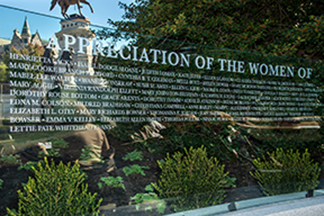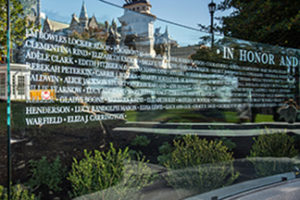
By Martha Wessells Steger
Special to the Eastern Shore Post
It’s been a long time coming, but Virginia women in history are getting recognition with the Virginia Women’s Monument on Capitol Square in downtown Richmond. Two Eastern Shore women — Dr. Susie May Ames and Anne Makemie Holden — are among the 230 names cited for making unique contributions to the commonwealth’s culture and history.
The inscribed names are literally reflected on the glass Wall of Honor at the monument. The Virginia Women’s Monument is the first monument in the nation to honor the many significant but usually unrecognized contributions of women.
This year is the 400th anniversary of the first English women coming to Virginia — in 1619 — in significant numbers. The brave female travelers who crossed the Atlantic Ocean under arduous conditions helped make the Virginia colony — and the nation — a permanent settlement for families. The lives of the two Eastern Shore women recognized span historical times from the Revolutionary War to the civil rights era of the 1960s.
Preacher’s Daughter, Patriot
In the 1700s, when women’s lives were defined by men — their fathers and husbands —Anne Makemie Holden (1702-1788) was no exception. Today’s travelers to Accomack County’s Makemie Monument Park in Grotons (in the Mappsville/Temperanceville area), can visit her grave, beside that of her father, Francis Makemie, recognized as chief founder of organized Presbyterianism in America in 1706.

An ordained minister educated at Glasgow University, Makemie settled on the Shore in 1683, according to genealogical records provided by Onancock descendant Joseph P. “Joe” Boggs. Boggs, who says he grew up knowing he was related to Makemie, has learned he’s related in “about five different ways.” He’s gone through all of the Makemie family wills and recommends books and online resources by historians “for all of the Makemie facts.”
Francis Makemie’s first home, “Matchatank,” was a land grant to Makemie from England’s King Charles II. The farm eventually comprised more than 450 acres of commercial enterprises, including shipbuilding operations, according to Boggs. Makemie became a wealthy landowner by combining various entrepreneurial efforts with his ministry, such as hauling cargo to Barbados during trips there to evangelize.
Daughter Anne – his only heir after his wife and other daughter died – became a wealthy woman through inheritances. Her father’s will had left his daughters more than two thousand acres spread among Smith Island, Sykes Island, Watts Great Island and “350 acres on the South side of Matchetank [sic] Creek.” Besides her father’s landholdings, she was widowed three times (Holden being the surname of her third husband) – but proved herself to be a very capable manager of her lands and business operations.
Expanding on her inheritance, she made her mission in life that of continuing her father’s mission – supporting individuals in the formation of towns, as opposed to encouraging life on individual plantations. The development of mills, for example, supported entire communities.
A woman who “could be feisty when necessary,” Boggs says Holden demonstrated “a revolutionary spirit when she refused to allow British militia in her home during the Revolutionary War.” Specific reference to her patriotism appears in historian Ralph T. Whitelaw’s papers referencing that in “1787 Madame Anne Holden made a deed of gift of her land in Fookses’ Neck to John, Francis, and Joseph Boggs which stated that, ‘In consideration of the Natural Love and affection which she bears to John, Francis and Joseph Boggs aforesaid and that they will always Vote at the Annual Election for the most Wise and Discreet men and who have proved theselves [sic] real friends to American Independence to represent the County of Accomack…’”
The Francis Makemie Society provides directions on its website to get to the Makemie Monument Park: In Temperanceville, turn west from U.S. 13 onto Route 695, Saxis Road, and proceed about 6 miles. Turn right on Monument Road and proceed to the park. Travelers can find at least nine highway markers related to the Makemie family within seven miles of the historical marker at Makemie Monument Park.
Professor, Historian
Coming forward a century, Susie May Ames was born in Pungoteague in 1888, exactly a hundred years after Anne Makemie Holden died. Ames, who never married, was the eldest of five daughters and the second of seven children of a local businessman, according to the “Dictionary of Virginia Biography” written by Dr. Jon Kukla and J. Jefferson Looney and published by the Library of Virginia in 1998.
In 1908 Ames graduated from Randolph-Macon Women’s College (later Randolph College) and was appointed an instructor there in 1923 after teaching and serving as principal in schools on the Eastern Shore and in Maryland, Indiana, and Kentucky. From 1923 to 1955, Ames “devoted her life to the college and its students,” according to the DVB. Her biography goes on to show she became “adjunct professor in 1926, associate professor in 1940 and professor in 1954. Ames was one of fewer than 500 women to earn a doctorate in history [at Columbia University] between 1920 and the completion of her graduate work in 1940. Her dissertation, published as “Studies of the Virginia Eastern Shore in the Seventeenth Century” (1940; reprinted 1973), was a pioneering investigation of social and economic history based on thorough analysis of the earliest county court records in the nation.”
Kukla explained in a telephone interview that although scholarship by women wasn’t valued in Virginia or in the South at large at the time, “Scholars at Columbia University and in other parts of the country clearly respected Ames’s work on early Virginia history.” Being “limited by gender,” he says, meant that without recognition by her male peers, “she lacked access to important contacts for her scholarship.”
Not to be deterred by the lack of male assistance, Ames edited — among many other works — two volumes of early Eastern Shore records, volumes still in use and “as solid today as when she was alive,” Kukla adds. (Ames died at The Hermitage in Onancock in 1969 and is buried at St. George’s Church cemetery near Pungoteague). “Because she was closed off from access to male audiences, Ames gave really excellent presentations to female audiences. In reading through them, I was struck by their outstanding quality. She stands out among only four or five historians of early Virginia and the Eastern Shore.”
Ninety-one-year-old Ridgway Dunton of Onancock, a member of the Eastern Shore of Virginia Historical Society – of which Ames was a founder and president – personally met Ames and recalls her as a tiny person who “was an absolute dynamo in terms of promoting the Eastern Shore. She did special events, he says, “like ‘Home and History Week’ to get people to return to the Shore for visits.” Of her writings, he specifically remembers her paper, “Federal Policy Toward the Eastern Shore of Virginia in 1861,” published in the “Virginia Magazine of History and Biography” in 1961, a paper, Kuka writes, prompted by issues of civil rights and Massive Resistance she observed in her later years.
Dedication Ceremony for Monument
When completed, the Virginia Women’s Monument will include 12 life-size, bronze statues on a granite plaza, of historic women representing a number of different fields and endeavors. The granite plaza and the Wall of Honor are completed and accessible to the public.
“These women played important roles in the early years of the Old Dominion’s recorded history and in the 20th century, when our state and country were undergoing seismic social changes,” said Susan Clarke Schaar, clerk of the Senate and a member of the Virginia Women’s Monument Commission. “Their stories richly deserve to be remembered and told.”
The full cost of the project, for the plaza, glass wall and sculptures, is $3.8 million, and has been mostly privately funded by individuals, corporations, and philanthropic organizations. Some funding came from the state.
The Women’s Monument Commission has been working on the project since 2011. The first four statues were commissioned in 2018, and commissioning of the next three was announced last week.
The remaining five statues — of Martha Washington, Clementina Rind, Sally L. Tompkins, Maggie L. Walker, and Sarah G. Jones — are partially funded and will be commissioned as contributions become available.
A formal dedication of the Virginia Women’s Monument is scheduled for Oct. 14, with most of the bronze statues expected to be installed by that time. Visitors will be able to walk up to the statues and learn more about the women and their stories through an educational component.
Fundraising is ongoing by the nonprofit, nonpartisan Virginia Capitol Foundation for the remaining five statues; contributions can be made online at www.virginiacapitol.gov


